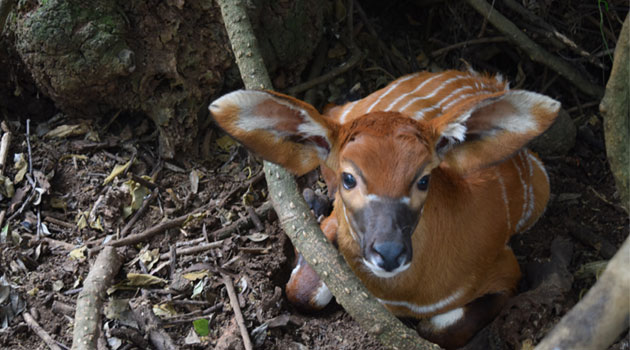
, NAIROBI, Kenya, Jul 8 – The Ministry of Tourism and Wildlife will set aside over 750 acres of land within Mount Kenya forest for the conservation of the critically endangered Mountain Bongo.
According to Tourism and Wildlife Cabinet Secretary, Najib Balala, the land will help protect the Mountain Bongo, whose numbers have dropped to below 100 animals in the wild.
With fewer than 100 Bongos left in the wild, the Mountain Bongo has been classified by the International Union for Conservation of Nature (IUCN), as a critically endangered species.
“The land set aside by the Kenya Forest Service will enable us to increase the number of Mountain Bongos to a sustainable population. We currently have 96 Mountain Bongos in the wild and 77 in captivity being used for breeding by the Mount Kenya Wildlife Conservancy,” CS Balala said.
According to Mount Kenya Wildlife Conservancy Trustee Margaret Mbaka, the conservancy’s Mountain Bongo Breeding program has grown its population from 18 Bongos to the current 77. The Conservancy currently hosts over 50% of all the Mountain Bongo population in the country. The program’s objective is to provide the National Bongo Task Force with the first individuals for release into their natural habitats by 2023 in line with the National Recovery and Action Plan 2019 – 2023.
“We are happy to report that we been working closely with the Kenya Forest Services to secure a special use license for a 776-acre protected area in Ontulili Forest to support its breeding program objectives. In line with national requirement, KWS and Mount Kenya Wildlife Conservancy undertook and presented an Environmental and Social Impact assessment to NEMA.”
“This continuous collaboration with Government agencies and stakeholders is key to the success of the National Recovery and Action Plan for the Mountain Bongo,” Mbaka added.
Key interventions in the National Recovery and Action Plan for the Mountain Bongo will focus on Security, Human Activities, Disease prevention, Species Interaction, enhancing breeding programs and Policy Harmonization.
From a security perspective, KWS will make provisions for the creation of Intensive Protection Zones staffed by a permanent security force engaged in daily patrols, anti-poaching, and de-snaring activities. To manage human activity around Bongo habitats KWS and its partners will work with Community Forest Associations and Host Communities to curb illegal activities and enhance sustainable practices.
The strategy will leverage ongoing local and international efforts to prevent the extinction of this iconic species. In 2010, the KWS brought together all the Bongo conservation players both local and international and assembled at green hills hotel Nyeri. The purpose was to look at what is/was ailing the species and to draw a way forwards towards the recovery of their population.
The initiative resulted in the formation of the National Bongo Task Force (NBTF) and the idea to develop a National Bongo Recovery and action plan was born. This was to ensure coordinated efforts that include the Bongo Surveillance Program to servile the wild population, Bongo habitat protection, Conservation education and advocacy programs for communities living around Bongo ranges, Captive and in-situ breeding programs.
The Bongo Surveillance program (BSP) has been central in establishing the current locations and numbers of the wild populations and the Rhino Ark in conjunction with KWS and other stakeholders have continued securing and protecting the habitats by constructing fences around them and providing security.
Incidentally, conserving the Mountain Bongo is a “one stone two birds tale” as the Mountain Bongo’s habitats are the country’s water towers and so by conserving the Bongo, we are conserving our water towers.
Post Views:
86